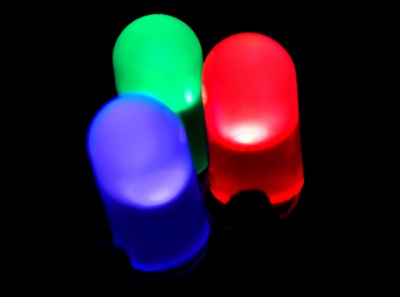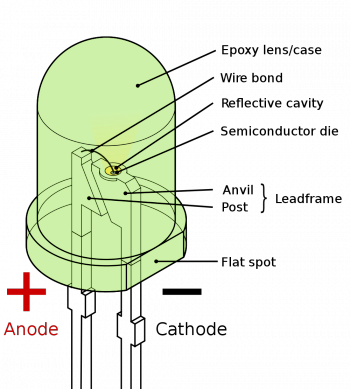|
Notice: This page contains information for the legacy Phidget21 Library. Phidget21 is out of support. Bugfixes may be considered on a case by case basis. Phidget21 does not support VINT Phidgets, or new USB Phidgets released after 2020. We maintain a selection of legacy devices for sale that are supported in Phidget21. We recommend that new projects be developed against the Phidget22 Library.
|
LED Primer: Difference between revisions
| (One intermediate revision by the same user not shown) | |||
| Line 66: | Line 66: | ||
===Choosing Current and Voltage Settings=== | ===Choosing Current and Voltage Settings=== | ||
Make sure to choose the minimum supply voltage setting to drive the LED that requires the most voltage during operation. Any extra voltage not required by the LED will be converted to heat by the | Make sure to choose the minimum supply voltage setting to drive the LED that requires the most voltage during operation. Any extra voltage not required by the LED will be converted to heat by the 1032. For example, a Blue LED being driven at 20mA, 3.9V Supply, that requires 3.7 volts will cause (3.9V-3.7V + 0.4V) * 0.02A = 12 milliwatts of heat to be produced on the 1032. If this example instead uses a high power, 1.5V infrared LED at 80mA, this will create (3.9V-1.5V+0.4V)*0.08 Amps = 224 milliwatts of heat. See the Heat Dissipation and Thermal Protection section later on in this manual for more information about this issue. | ||
==Multiplexed LEDs== | ==Multiplexed LEDs== | ||
Latest revision as of 17:52, 31 January 2013

|
Introduction
Like normal diodes, Light Emitting Diodes (LEDs) are semiconductor devices designed to conduct current in one direction only. What makes LEDs unique is their internal material makeup: when atoms in an LED release energy due to the flow of forward current, it is released in the form of photons (light). Different construction materials and various phosphor coatings are used to produce numerous colors of light.
LEDs that Phidgets sells are all operable via the digital outputs on any of our interface kits. However Phidgets also sells a specific PhidgetLED-64 Advanced LED controller since it is often desirable to control more LEDs than even the 1012 Phidget Interface Kit 0/16/16 can operate. It offers some unique features such as brightness control.
How it works
LEDs emit light from current flowing through them. As the current flows, the electronics experience a sudden drop in energy level (voltage). When that happens they release energy in the form of light. The amount of light produced is proportional to the current. Depending on the material used to make the LED, different colors can be created. Like a conventional diode, the current can only flow in one direction - from the anode to the cathode.
Controlling LEDs
Forward Voltage
The materials used within LEDs that cause them to emit different colors of light affect a property called its forward voltage. The forward voltage is the voltage at which current in the forward direction will flow through the device and allow the LED to convert electrical energy into light. If the voltage applied to the LED is below the forward voltage of the LED, very little current (or none) may flow, and therefore very little light will be emitted. Most standard LEDs with colors such as red, amber, orange, yellow, and green have forward voltages below 2.75 Volts, and can be used with a digital output by simply soldering them to a connector-wire and inserting the wire into the output port. The forward voltage in the 1032 - PhidgetLED will default to 2.75V, and the maximum current defaults to 20mA.
Supply Voltage
| To be an effective LED controller your digital outputs must be capable of adjusting the forward voltage supplied to the LEDs to 1.7, 2.75, 3.9 and 5 volts settings allowing you to properly drive blue, white, violet, ultra violet and purple LEDs. The supply voltage will affect all LEDs. If you set the supplied voltage too high, power will be wasted and the controller may shut down from thermal overload. If you set the supply voltage too low, your LEDs will not be driven at the requested current, and will be dim or non-functional. |
| ||||||||||||||||||||
Maximum Current and Brightness Control
|
Most LEDs have a current rating of 20, 40, 60 or 80mA. The Phidgets DiscreteLED API call can be used to provide more current or control brightness and will adjust the current linearly between 0 and the set maximum. This however does not imply a precise method for controlling the visibility of emitted light, as this is affected by the construction and quality of the LED as well as the eyes of the viewer. Be cautious when changing the current property. Many small LEDs are designed for a maximum 20mA, and can be destroyed if driven at higher currents. |
|
Choosing Current and Voltage Settings
Make sure to choose the minimum supply voltage setting to drive the LED that requires the most voltage during operation. Any extra voltage not required by the LED will be converted to heat by the 1032. For example, a Blue LED being driven at 20mA, 3.9V Supply, that requires 3.7 volts will cause (3.9V-3.7V + 0.4V) * 0.02A = 12 milliwatts of heat to be produced on the 1032. If this example instead uses a high power, 1.5V infrared LED at 80mA, this will create (3.9V-1.5V+0.4V)*0.08 Amps = 224 milliwatts of heat. See the Heat Dissipation and Thermal Protection section later on in this manual for more information about this issue.
Multiplexed LEDs
Multiplexing is a system wherein the entire display is not active at the same time. Instead, sub-units of the display are driven one at a time and the electronics combine with human persistence of vision (the phenomenon of the eye by which an afterimage is thought to persist for approximately one twenty-fifth of a second on the retina) to make the viewer believe the entire display is continuously active. Many controllers use this architecture to reduce power consumption. 7 segment display clocks are an example of this.
In an effort to reduce electrical noise in the system the PhidgetLED does not use multiplexing. All 64 anodes are connected to the same power supply and the cathode of each LED connection is attached to an individual constant current sink. Also, the LEDs are not controlled by PWM - they are driven at a constant current.
Other uses for LED controllers
LED controllers are typically just a set of special digital outputs. This means they aren't limited to just controlling LEDs. They can be used to control relays, solenoids and even very small motors. The PhidgetLED can also be used to drive opto-isolators and MOSFET SSRs. A diode integrated into the 1032 on each cathode will clamp inductive surges to the anode supply voltage.
Power Requirements and Power Supply Selection
The power supply that is included with the 1032 is rated at 12V and 2A (max). If your application requires more power, a larger power supply may be necessary. The on-board voltage regulator is able to supply up to 6A for each LED supply voltage setting, as long as the power supply is able to provide enough voltage and current to the regulator. Assume an efficiency of 80% for the on-board voltage regulator when determining if a different power supply is required.


